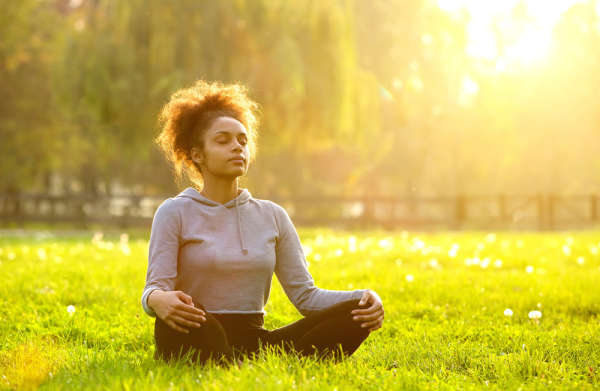
There are several different anxiety disorders, each with a distinct set of symptoms. However, common symptoms can include:
- sweating
- dizziness
- trembling
- increased or irregular heartbeat
- back pain
- restlessness and fatigue
- muscle tension
- being easily startled
- recurring and ongoing feelings of worry, with or without known stressors
- avoidance of certain situations that may cause worry, often affecting quality of life
It is crucial that passing feelings of anxiety are seen as temporary to avoid increasing the amount of worry and the risk of an anxiety disorder. However, it is also important not to ignore symptoms of anxiety disorders so that timely treatment can be received.
People with an anxiety disorder often present symptoms similar to clinical depression and vice-versa. It is rare for a patient to exhibit symptoms of only one of these conditions.
Treatment
 Psychotherapy is one recommended treatment for anxiety.
Psychotherapy is one recommended treatment for anxiety.Treating a person with anxiety depends on the causes of the anxiety and individual preferences. Often, treatments will consist of a combination of psychotherapy, behavioral therapy, and medication.
Alcohol dependence, depression, or other conditions can sometimes have such a strong effect on the individual that treating the anxiety disorder must wait until any underlying conditions are brought under control.
Self-treatment
In some cases, anxiety can be treated at home without a doctor’s supervision. However, this may be limited to shorter periods of anxiety and more obvious causes.
There are several exercises and actions that are recommended to cope with this type of anxiety:
- Stress management: Learning to manage stress can help limit potential triggers. Keep an eye on pressures and deadlines, compile lists to make daunting tasks more manageable, and commit to taking time off from study or work.
- Relaxation techniques: Simple activities can be used to relax mental and physical signs of anxiety. These include meditation, deep breathing exercises, long baths, resting in the dark, and yoga.
- Exercises to replace negative thoughts with positive ones: Make a list of the negative thoughts you experience, and write down a list of positive, believable thoughts to replace them. Picturing yourself successfully facing and conquering a specific fear can also be beneficial if the anxiety symptoms are related to a specific cause.
- Support network: Talk with a person who is supportive, such as a family member or friend.
- Exercise: Physical exertion can improve self-image and release chemicals in the brain that trigger positive feelings.

Counseling
A standard way of treating anxiety is psychological counseling. This can include cognitive-behavioral therapy (CBT), psychotherapy, or a combination of therapies.
CBT aims to recognize and change the thinking patterns associated with the anxiety and troublesome feelings, limit distorted thinking, and change the way people react to objects of situations that trigger anxiety.
For example, a person taking CBT for panic disorder involve learning that panic attacks are not really heart attacks. CBT is an exposure-based therapy that encourages people to confront their fears and helps reduce sensitivity to their usual triggers of anxiety.
Psychotherapy is another type of counseling. It consists of talking with a trained mental health professional, psychiatrist, psychologist, social worker, or counselor.
Sessions may be used to explore the causes of anxiety and possible ways to cope with symptoms.
Medications

Anxiety can be treated using several types of drugs.
In cases where anxiety has a physical cause, such as an imbalance in brain chemistry or high blood pressure, drugs will be prescribed to treat the underlying condition.
Other medicines are used to control some of the physical and mental symptoms include antidepressants, benzodiazepines, tricyclics, and beta-blockers.
Benzodiazepines are prescribed, but they can be highly addictive. These drugs tend to have few side effects except for drowsiness and possible dependency. Diazepam, or Valium, is an example of a commonly prescribed benzodiazepine.
Anti-depressants are also commonly used to treat anxiety, even though they were designed to treat depression. Serotonin reuptake inhibitors (SSRI) are often used and have fewer side effects than older anti-depressants. They are still likely to cause jitters, nausea, and sexual dysfunction when treatment begins. Some anti-depressants include fluoxetine, or Prozac, and citalopram, or Celexa.
Tricyclics are a class of drugs older than SSRIs that have been shown to work well for most anxiety disorders other than OCD. These drugs are known to cause side effects such as dizziness, drowsiness, dry mouth, and weight gain. Two examples of tricyclics are imipramine and clomipramine.
Additional drugs used to treat anxiety include:
- monoamine oxidase inhibitors (MAOIs)
- beta-blockers
- buspirone
Be sure to update your physician if the adverse effects of any prescribed medications.
Prevention
Although anxiety disorders cannot be prevented, and anxious feelings will always be present in daily life, there are ways to reduce the risk of a full-blown anxiety disorder.
Taking the following steps will help keep anxious emotions in check:
- Reduce caffeine, tea, cola, and chocolate consumption.
- Check with a doctor or pharmacist before using over-the-counter (OTC) or herbal remedies to see if they contain chemicals that may make anxiety worse.
- Maintain a healthy diet.
- Keep a regular sleep pattern.
- Avoid alcohol, cannabis, and other recreational drugs.
Source:
https://www.medicalnewstoday.com/info/anxiety/symptoms-of-anxiety.php
https://www.medicalnewstoday.com/info/anxiety/anxiety-treatments.php
